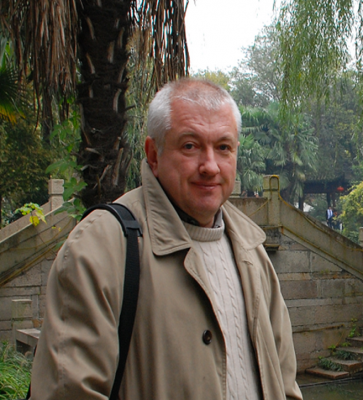Address: Max-Planck-Institut für Chemische Physik fester Stoffe
Nöthnitzer Straße 40
01187 Dresden
Germany
Phone: +49 351 4646 4000
Fax: +49 351 4646 4002
E-mail: grin@cpfs.mpg.de
Vita
Chemistry major and PhD at Chemistry Faculty of the Lviv State University, Ukraine.
Faculty staff with academic appointment of assistant professor, associate professor, vice-president at the Lviv State University.
Researcher at the Max-Planck-Institut für Metallforschung and the Max-Planck-Institut für Festkörperforschung in Stuttgart, head of research group at the Max-Planck-Institut für Chemische Physik fester Stoffe in Dresden, Germany.
2001- 2023 - Scientific Member of the Max Planck Society and Director at Max-Planck-Institut für Chemische Physik fester Stoffe (Department Chemical Metals Science) in Dresden, faculty member and honorary professor in chemical metal science at the Dresden University of Technology, Germany.
Since 2023 – Director Emeritus at the Max-Planck-Institut für Chemische Physik fester Stoffe in Dresden.
Honours, distinctions, scholarships, awards
Fellowship of the ÖAAD at Institute of Physical Chemistry, University of Vienna, Austria
Alexander von Humboldt Fellow at Max-Planck-Institut für Metallforschung in Stuttgart
Guest professor at the University of Rennes, France
Visiting professor of the Chinese Academy of Sciences
Visiting professor at ENSICAEN, Caen, France
Adjunct Professor of the University of Shanghai, China
Doctor philosophiae honoris causa of the National Academy of Sciences of Ukraine
V. I. Vernadsky Gold Medal of the National Academy of Sciences of Ukraine for the outstanding achievements in thermoelectric materials science
Professor Honoris causa, Institute of Low Temperatures and Structure Studies (ITNiBS) of the Polish Academy of Sciences, Wroclaw, Poland
Carl–Hermann-Medal of the German Crystallographic Society
Outstanding Achievement in Thermoelectrics Award of the International Thermoelectric Society
Publications
More than 800 scientific publications (h > 60), 15 patents.
Lecture 51: Yuri Grin
Chemical bond in intermetallic compounds:
an electron density-based position- space approach
Yuri Grin
Max-Planck-Institut für Chemische Physik fester Stoffe, Dresden, Germany
Juri.Grin@cpfs.mpg.de
Intermetallic compounds contain only elements located at the Zintl line and to the left of it in the periodic table of elements. The low number of electrons in the last shell hinders the application of bonding concepts based on the 8–N rule to understand the crystal structure and the chemical composition [1]. As to the chemical bonding concepts, intermetallic compounds do not follow classical valence rules. It is impossible to consider all shortest interatomic contacts as 2c-2e bonds in their crystal structures. The demand on new bonding concepts for this family of inorganic materials is still actual. One of the possible ways to develop new concepts is opened by Hohenberg-Kohn theorems [2]. If the true electron density of the ground state yields the lowest energy and determines properties of the system, it makes a sense to describe also chemical bond using electron density in order to have a direct link to the properties.
Among the quantum chemical tools suitable for this purpose, is the bonding analysis based on electron density in position space, the electron localizability approach, attracts attention during last decades [1]. First considered as a way to establish the connection between the classical and quantum chemical perspective of chemical bond, this approach develops into a powerful tool for investigative studies of atomic interactions, especially in solids, in particular in intermetallic compounds. The position-space partitioning for this analysis is based on the electron density distribution, which is an observable property of the system [3]. Still under investigation is the question, what chemical and physical information can be obtained employing this approach.
Analysis of atomic shapes obtained from the topology of electron density within the Quantum Theory of Atoms in Molecules (QTAIM) [4] allows not only the quantization of atomic volumes and effective charges, but by description applying solid angles allows to estimate the effective topological coordination numbers (tCN) [5]. The latter may contain also the information about atomic interactions in crystal structures.
The Topological Octet Rule Implementation (TORI) approach [6] allows to expand the basic Lipscomb’s model construction of localized 2c-2e and 3c-2e bonds by dropping the 2-electron component and to analyze the fulfilment of the octet rule in both, local and cluster-wise ways in multiatomic clusters. This may open a conceptual way to establish the bonding pattern analyzing the topological characteristics of clusters only.
Chemical bonding influences total electron balance in thermoelectric materials regulating the charge carrier concentration (transport properties) and controls heat transport. The co-existence of different bond types in substances (bonding inhomogeneity) supports reduction of the lattice thermal conductivity effecting most probably the speed of sound [7]. The anisotropy in spatial distribution of regions with different bond types (bonding anisotropy) affects the directional dependence of thermal and electronic transport.
Recent developments in electron-localizability approach make also the quantitative description of the surface state possible, allowing the interpretation of the experimental results in catalysis on intermetallic compounds [8,9].
[1] Wagner, F. R., Grin, Yu. (2023). In: Comprehensive Inorganic Chemistry III; Elsevier: Oxford, UK, 3, 222.
[2] Hohenberg, P., Kohn, W. (1964). Phys. Rev. B 136, 864.
[3] Silvi, B. et al. (2013). In: Comprehensive Inorganic Chemistry II; Elsevier: Oxford, UK, 9, 187.
[4] Bader, R. F. W. (1994). Atoms in Molecules: A Quantum Theory, Clarendon Press, 22, 438.
[5] Wagner, F. R. et al. (2025). Acta Crystallogr. A81, 221.
[6] Wagner, F. R., Grin, Yu. (2024). Inorg. Chem. 63, 20205.
[7] Grin, Yu. (2019). J. Solid State Chem. 274, 329.
[8] Antonyshyn, I. et al. (2018) Inorg. Chem. 57, 10821.
[9] Aras, F. et al. (2025). ACS MaterialsAu, 5, 718.


